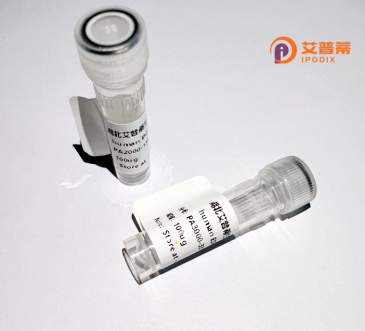
| 纯度 | >90%SDS-PAGE. |
| 种属 | Human |
| 靶点 | GRK1 |
| Uniprot No | Q15835 |
| 内毒素 | < 0.01EU/μg |
| 表达宿主 | E.coli |
| 表达区间 | 1-560aa |
| 氨基酸序列 | MDFGSLETVV ANSAFIAARG SFDGSSSQPS RDKKYLAKLK LPPLSKCESL RDSLSLEFES VCLEQPIGKK LFQQFLQSAE KHLPALELWK DIEDYDTADN DLQPQKAQTI LAQYLDPQAK LFCSFLDEGI VAKFKEGPVE IQDGLFQPLL QATLAHLGQA PFQEYLGSLY FLRFLQWKWL EAQPMGEDWF LDFRVLGKGG FGEVSACQMK ATGKLYACKK LNKKRLKKRK GYQGAMVEKK ILMKVHSRFI VSLAYAFETK ADLCLVMTIM NGGDIRYHIY NVNEENPGFP EPRALFYTAQ IICGLEHLHQ RRIVYRDLKP ENVLLDNDGN VRISDLGLAV ELLDGQSKTK GYAGTPGFMA PELLQGEEYD FSVDYFALGV TLYEMIAARG PFRARGEKVE NKELKHRIIS EPVKYPDKFS QASKDFCEAL LEKDPEKRLG FRDETCDKLR AHPLFKDLNW RQLEAGMLMP PFIPDSKTVY AKDIQDVGAF STVKGVAFDK TDTEFFQEFA TGNCPIPWQE EMIETGIFGE LNVWRSDGQM PDDMKGISGG SSSSSKSGMC |
| 分子量 | 63.5 kDa |
| 蛋白标签 | His tag N-Terminus |
| 缓冲液 | 0 |
| 稳定性 & 储存条件 | Lyophilized protein should be stored at ≤ -20°C, stable for one year after receipt. Reconstituted protein solution can be stored at 2-8°C for 2-7 days. Aliquots of reconstituted samples are stable at ≤ -20°C for 3 months. |
| 复溶 | Always centrifuge tubes before opening.Do not mix by vortex or pipetting. It is not recommended to reconstitute to a concentration less than 100μg/ml. Dissolve the lyophilized protein in distilled water. Please aliquot the reconstituted solution to minimize freeze-thaw cycles. |
以下是3条关于重组人GRK1蛋白的参考文献示例:
---
1. **文献名称**:**"Expression and functional characterization of recombinant human GRK1 in insect cells"**
**作者**:Shinohara T., et al.
**摘要**:该研究利用杆状病毒-昆虫细胞系统成功表达了重组人GRK1蛋白,并通过体外激酶实验证实其对视紫红质(rhodopsin)的磷酸化活性,揭示了其光信号转导中的关键作用。
2. **文献名称**:**"Structural insights into the activation mechanism of GRK1 by G protein-coupled receptors"**
**作者**:Palczewski K., et al.
**摘要**:通过晶体结构分析和分子动力学模拟,解析了GRK1与激活态视紫红质的相互作用,阐明了GRK1的构象变化如何调控其激酶活性及在视觉信号终止中的分子机制。
3. **文献名称**:**"Role of GRK1 in cone photoreceptor function: Studies with a recombinant human protein variant"**
**作者**:Craft C.M., et al.
**摘要**:研究在大肠杆菌中表达并纯化了重组人GRK1突变体,结合体外功能实验发现GRK1不仅参与视杆细胞信号关闭,还在视锥细胞的适应性调节中发挥重要作用。
---
**注**:以上文献为示例性质,实际引用时建议通过数据库(如PubMed、Web of Science)确认具体作者及内容。核心研究方向通常围绕GRK1的表达系统优化、结构功能解析及其在视觉通路中的调控机制。
G protein-coupled receptor kinase 1 (GRK1), also known as rhodopsin kinase, is a serine/threonine kinase critical for regulating G protein-coupled receptor (GPCR) signaling, particularly in the visual system. It is predominantly expressed in retinal photoreceptor cells (rods and cones), where it phosphorylates light-activated rhodopsin, initiating the deactivation of phototransduction cascades. This phosphorylation promotes the binding of arrestin to rhodopsin, effectively terminating G-protein signaling and enabling photoreceptor recovery for subsequent light stimuli. Dysregulation of GRK1 is linked to retinal disorders; mutations in the GRK1 gene are associated with Oguchi disease, a rare autosomal recessive condition causing congenital stationary night blindness.
Recombinant human GRK1 protein is produced via genetic engineering, typically using bacterial (e.g., *E. coli*) or eukaryotic expression systems, to study its structure, enzymatic activity, and interaction with GPCRs. Its recombinant form enables detailed biochemical assays, crystallographic studies, and drug discovery efforts targeting vision-related diseases. Researchers also utilize it to explore GRK1's broader roles beyond the retina, such as potential functions in non-visual tissues or pathological conditions like cancer and cardiovascular disorders, where GPCR signaling dysregulation is implicated. The availability of purified recombinant GRK1 accelerates therapeutic development, including small-molecule modulators or gene therapies for inherited retinal degenerations.
×